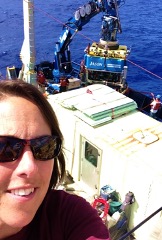
| email: sherylmurdock@gmail.com lab phone: 250-472-5427 |
Background
My research up to now has been firmly rooted in the deep sea, specifically focused on understanding the microbial ecology of hydrothermal vents using both culturing and molecular DNA-based approaches. In hydrothermal vent ecosystems, far below the reach of sunlight, microbes live chemosynthetically and support communities of animals that are unique to these extreme habitats. Most recently I have become interested in connections between biological components of ecosystems that are often studied in isolation, such as microbes and higher organisms, and how by understanding those connections we can improve models of ecosystem function. During my PhD, I used microbial and faunal covariances to help bridge the extensive, yet disconnected, knowledge of these two groups in hydrothermal systems. Inferred connections between microbes and fauna were used to focus metagenomic exploration of functional contributions to the ecosystem on species belonging to so called “core communities”.
Current research
My research in the Varela lab will take me out of my deep-sea comfort zone to focus on identifying links between autotrophic and heterotrophic euphotic zone microbial communities across regions of the Northeast Pacific and into the arctic. This work is part of the Oceans of Biodiversity project, which aims to catalog marine biodiversity and characterize important links spanning size classes and trophic levels. I am particularly interested in characterizing the diversity of diazotrophs (nitrogen fixing microbes), trying to understand their potential to alleviate nitrogen limitation in diatoms as the duration of ice-free periods in the arctic increases, and investigating the potential downstream effects on food web dynamics.
Degrees and research experience
2021 – Ph.D., Earth & Ocean Sciences, University of Victoria
2006-2014 – Research technician, S. Kim Juniper lab, University of Victoria
1996-2006 – Research technician, John Baross lab, University of Washington
1998 – B.Sc., Biological Oceanography, University of Washington
Peer-Reviewed Journal Papers
Murdock SA, Tunnicliffe V, Boschen-Rose RE, & SK Juniper (2021). Emergent ‘core communities’ of microbes, meiofauna and macrofauna in hydrothermal vents. ISME Communications 1, 27. doi.org/10.1038/s43705-021-00031-1.
Orcutt B, Bradley JA, Brazelton WJ, Estes ER, Goordial JM, Huber JA, Jones RM, Mahmoudi N, Marlow JJ, Murdock S and M Pachiadaki (2020). Impacts of deep-sea mining on microbial ecosystem services. Limnology & Oceanography65(7):1489-1510.
Murdock S and SK Juniper (2019). Hydrothermal vent protistan distribution along the Mariana Arc suggests vent endemics may be rare and novel. Environmental Microbiology 21(10):3796-3815.
Crump BC, Fine LM, Fortunato CS, Herfort L, Needoba JA, Murdock SA & FG Prahl (2017). Quantity and quality of particulate organic matter controls bacterial production in the Columbia River estuary. Limnology & Oceanography62:2713-2731.
Murdock S and SK Juniper (2017). Capturing compositional variation in denitrifying communities: A multiple primer approach that includes Epsilonproteobacteria. Applied and Environmental Microbiology. 83:e02753-16.
Bourbonnais A, Juniper SK, Butterfield DA, Devol AH, Kuypers MMM, Lavik G, Hallam SJ, Wenk CB, Chang BX, Murdock SA, and MF Lehmann (2012). Activity and abundance of denitrifying bacteria in the subsurface biosphere of diffuse hydrothermal vents of the Juan de Fuca Ridge. Biogeosciences 9:1-18.
Murdock S, Johnson H, Forget N, and SK Juniper (2010). Composition and diversity of microbial mats at shallow hydrothermal vents on Volcano 1, South Tonga Arc. Cah. Biol. Mar. 51:407-413.
Forget NL, Murdock SA, and SK Juniper (2010). Bacterial diversity in Fe-rich hydrothermal sediments at two South Tonga Arc submarine volcanoes. Geobiology 8:417-432.
